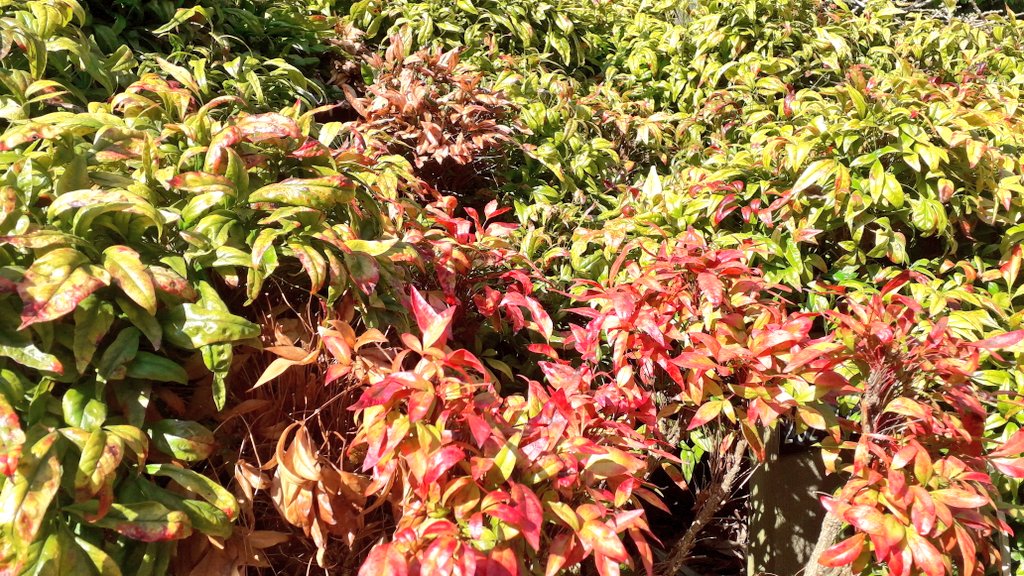Nandina domestica, widely known as nandina heavenly bamboo, heavenly bamboo or sacred bamboo, are evergreen flowering plants from the Berberidaceae family.
Nandina heavenly bamboo plants are shrubs, not real bamboo plants from the grass family, Poaceae.
Heavenly bamboo is the perfect ornamental plant for small gardens and pots.
There are several cultivars that produce stunning bright red berries and foliage in autumn and winter.
They are undemanding and low maintenance.
You can propagate heavenly bamboo plants from stem cutting, root cutting or seed.
Nandina heavenly bamboo features
- Botanical name: Nandina domestica
- Common name: Sacred bamboo, Heavenly bamboo
- Family: Berberidaceae
- Plant type: Slow-growing shrub
- Native to: Eastern Asia to Japan
- Flowers in: Summer
- Berries: Bright red in Spring
- Foliage: Evergreen (leaves green to bright red)
- Propagation by: Root/stem cuttings, seeds
- Soil: Well-drained moist, slightly acidic
- Position: Full sun/Part shade
- Height: 2 metres
- Width: 1.5 metres
- Uses: Small garden, pots and planters
- Toxicity: Berries are mildly toxic to pet animals and birds if eaten in large quantities
What are the cultivars of nandina heavenly bamboo plants?
There are several types of nandina, but the 5 listed below are common in the UK.
They have white flowers in summer with stunning arrays of foliage.
Notably, the new foliage tends to change colour from summer to autumn to winter and spring. Yet, they are evergreen shrubs and do not lose their leaves through all the colour changes.
- 1) Nandina domestica ‘Fire Power’ – upright, evergreen shrub with bright red foliage in autumn.
- 2) Nandina domestica ‘Gulf Stream’ – new foliage is reddish-brown, turns green to red, white flowers in summer.
- 3) Nandina domestica – upright, evergreen shrub with white flowers, red berries and reddish foliage in autumn and spring.
- 4) Nandina domestica ‘Magical Lemon and Lime’ – new foliage is light yellow to green, turning deep green as it matures.
- 5) Nandina domestica ‘Obsessed’ – upright, evergreen shrub with white flowers and fire-engine red new shoots, foliage turn green in summer and red again in autumn as it matures.
Heavenly bamboo plants for sale: All 5 cultivars are available at Thompson and Morgan (visit product page).
You may also be interested in other plant alternatives to bamboo with bamboo names.
Is Nandina heavenly bamboo a bamboo plant?
The leaves look like those of the bamboo plants that is why it is called Heavenly Bamboo.
In fact, nandina heavenly bamboo is from the shrub family Berberidaceae and not grass family Poaceae. It is not clumping or running a bamboo plant.
Nandina doemstica plant is a good alternative to bamboo plants as it provides an evergreen cover all year round.
How to propagate heavenly bamboo?
The quickest (and probably best) way to propagate nandina heavenly bamboo is from a root cutting.
- Carefully take root cutting and propagate it in a grow pot.
- Use well-drained moist loam soil or a potting mixture until it is ready for transplanting.
You can also grow nandina heavenly bamboo from stem cutting. Take the cutting, preferably, in summer and grow it in a propagating medium until roots appear.
However, it can take longer compared to growing it from a root cutting
Growing heavenly bamboo from seeds can take much longer, but you can get lots of plants from the seeds.
The seeds are normally ready in late autumn and winter when it turns vibrant red.
- Pick the seeds and sow them in a propagator until they grow.
- Then, transplant them into grow pots before planting them in the garden.
- It can take 6-12 months before transplanting them, and it depends on the conditions.
How to grow healthy heavenly bamboo in the garden?
Nandina heavenly bamboo is undemanding and easy to grow. It can grow well in any location, but the colours of the foliage and berries are prominent in the sun.
Plant in spring when new growths are emerging.
- Plant Nandina heavenly bamboo in well-drained, moist soil. It will also tolerate slightly acidic soil.
- Add mulch with bark chips after planting.
- Water generously until they are well established.
How to prune nandina heavenly bamboo plants?
Nandina is a slow-growing plant, that rarely needs pruning. However, light trimming especially in spring may be required to promote new growth. It is also the perfect way to keep it in shape.
It is a vigorous plant and will grow new shoots as soon as spring arrives.
Cut at a 45 degrees angle from the nodes with a clean pair of secateurs.
Remove any old plant that looks tired. Take it completely off the bottom so that new plants can take over.
Conclusion
Nandina sacred heavenly bamboo plants have the perfect evergreen foliage that changes colours throughout the different seasons.
They are well-known for their beautiful white flowers in summer, and fiery red leaves and berries in winter and autumn. They are undemanding and easy to grow.


No comments:
Post a Comment
Thank you for the comment.